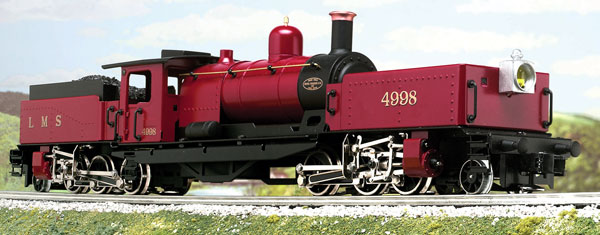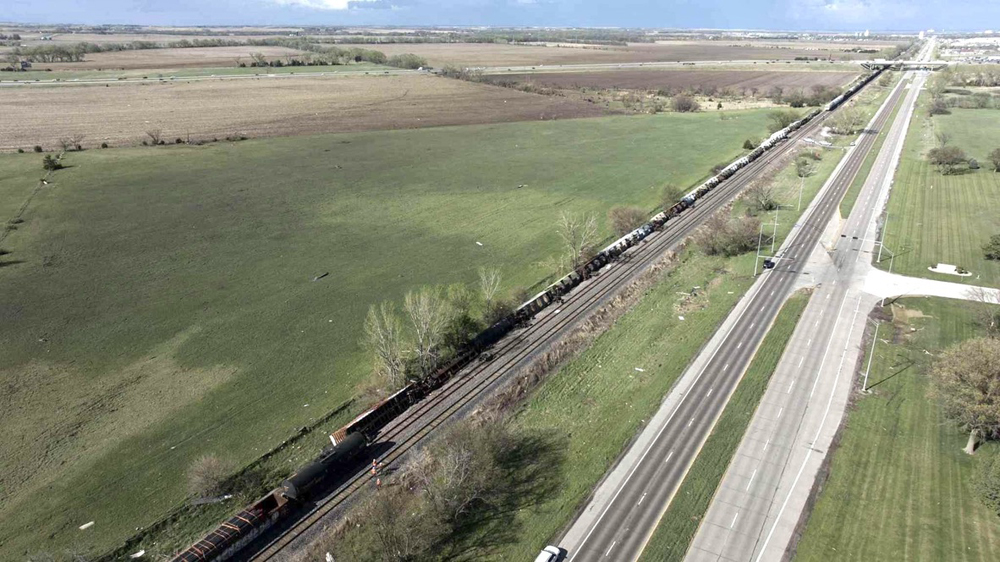A fellow named H.W. Garratt came up with a patented design for an articulated locomotive with a water tank up front, a boiler in the middle, and a coal bunker (and smaller water tank) out back, all riding on two widely spaced sets of drive wheels.
Beyer, Peacock & Co. of Manchester, England, built the Garratts, and the first – an 0-4-0+0-4-0 locomotive – was constructed in 1909 for the 2-foot narrow gauge Tasmanian Railway. Later Garratts were built with wheel arrangements all the way up to 4-8-4+4-8-4.
Like American Big Boy, Challenger, and Allegheny locomotives, Garratts filled a need to pull longer and heavier trains without the waste associated with doubleheading ordinary locomotives. But unlike American designers, Mr. Garratt displayed some “out of the box” thinking.
A Garratt’s boiler is supported on a girder frame, instead of resting on driving wheels like a conventional locomotive. Tenders on each end of the frame, supported by driving-wheel assemblies, pivot left and right.
This design leaves plenty of space for a wide-girth boiler and a deep firebox, important considerations when constructing a locomotive. The Garratt is also more agile than a conventional articulated locomotive, since there are two pivot points instead of one. Also, it has almost no overhang on curves.
These selling points were especially attractive to narrow gauge railroads with sharp curves and rugged terrain. Not surprisingly, most Garratts spent their lives steaming up and down narrow gauge lines in Africa and South America. North America’s wide-open vistas negated the selling points of Garratts. That’s why the odds are you’ve never heard of a Garratt until today.
Most Garratts were narrow gauge locomotives. The London Midland & Scottish Railway and London North Eastern Railway in Great Britain were among the few owners of standard gauge Garratts.
The model
Our sample O gauge Garratt wasn’t built in England, but instead comes from the Czech Republic by way of New Jersey. ETS locomotives and rolling stock, built in a small shop in Prague, are now marketed in North America under the name Semaför. The company’s U.S. arm is headquartered in Roselle Park, N.J. While the name may be different, these are the same ETS trains that we reviewed in the May 2004, March 2002, and November 2000 issues of CTT.
The Semaför Garratt is constructed of sheet metal and reminds us of the craftsmanship of Lionel locomotives built in the 1920s and early 1930s. Pieces are neatly tabbed or screwed together, and sharp edges are folded back. It’s clear that ETS took no shortcuts in the locomotive’s construction.
The Semaför model is a generic 1:45 scale version of a Garratt. (O gauge track is technically 1:45, although that ratio has for decades been rounded off in the United States to 1/4 scale or 1:48).
The O gauge locomotive duplicates the main points of 2-6-0+0-6-2 Garratts used on the London Midland & Scottish Ry. Existing ETS tooling is used for pieces like the cab, boiler, tender shells, smokestack, and front and rear lanterns. While scale modelers may find fault with that, toy train enthusiasts will find the Garratt charming.
Our sample LMS locomotive was painted a deep glossy red with black and gold accents. Examining the Garratt’s paint job, we could not find any runs, drips, or errors.
ETS also offers the same Garratt in Railways of South Africa (black paint) and Argentina FCER (green paint).
On the test track
Put aside any thoughts of RailSounds, ProtoSound, and speed control. This Garratt is a basic, conventionally controlled electric train.
Beneath the tender shells are thumb-sized, can-style motors. Each drive train uses ETS’s patented clutch system. The drive wheels are free-rolling until power is applied to the locomotive, when a clutch engages to connect the motor to the wheels. The clutch disengages when power is shut off, allowing the locomotive to roll to a gentle stop.
There is no neutral, just forward and reverse. Our sample is what Semaför calls the 3AC-0 or “B” version, in which reversing is engaged by interrupting power, as with a traditional American O gauge train. (Other versions use a Märklin-style pulse of power to engage reverse.) The headlight and reverse light – actually lanterns – operate directionally.
Reversing worked fine on all the transformers we tested, with the exception of a Lionel TMCC setup on one of our home test layouts. Using a CAB-1, an older version of an IC Controls TPC 4000, and PowerHouse transformers, the Garratt (and other ETS locomotives we’ve tested) would only occasionally obey our reverse commands.
Our “B” version comes with plastic, body-mounted Lionel-style knuckle couplers with “thumbtacks” mounted underneath. The Garratt can also be purchased with a smoke unit, two types of European couplers, and in a DC two-rail version. Some of these options are sold as a package and others on an ala carte basis, which can get a touch confusing when looking at a catalog or price sheet. If in doubt, call Semaför.
On the test track, our low-speed average was 8 scale mph and our high-speed average was 76 scale mph. Even at reasonably slow operating speeds, say around 20 scale mph, the Garratt had plenty of grunt to pull trains around curves and up slight inclines at a steady pace with very little throttle input. Operation was silent except for some mechanical whirring.
Drawbar pull for the 2-pound, 2-ounce Garratt is 11 ounces on tubular track. On a home test layout, the Garratt pulled more than expected for a relatively light locomotive without traction tires.
With two motors and 12 powered drive wheels on tubular track, it could pull a 12-car train comprised of postwar Lionel gondolas.
Underway, the locomotive accelerated smoothly. Its gearing minimized throttle input. The locomotive pulled its train without adjustments around 180-degree curves and up and down subtle grades.
ETS recommends O-54 curves for the Garratt. Our sample pivoted through O-42 curves and O-42 Ross switches with a 1/8-inch clearance between the locomotive frame and tenders, but the arm of the body-mounted knuckle coupler does not swing quite far enough to keep the knuckle centered.
In a hobby that’s deeply rooted in the past yet yearns for new trains, the Semaför Garratt addresses both. While built in a time-honored style, this O gauge Garratt is the perfect response to the age-old question “What’s New?”














